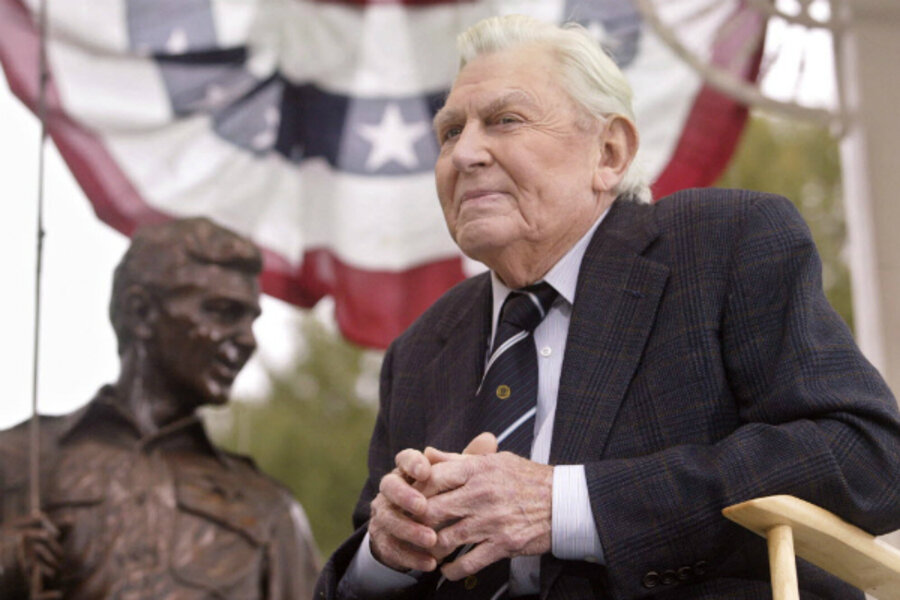Andy Griffith: why we should remember him as more than 'America's Sheriff'
Loading...
| Los Angeles
In the remembrances and appreciations of Andy Griffith – who died Tuesday at his home in Manto, N.C. – Americans are discovering a man of far more breadth and depth than the on-screen persona he displayed in his incarnation as Sheriff Andy Taylor in “The Andy Griffith Show,” which ran from 1960 to 1968.
First off, he was a singer and musician whose 1996 album, “I Love to Tell the Story: 25 Timeless Hymns,” went platinum. He also had an early career in theater. He could also play very dark with great credibility. That was evidenced by his first film, 1957’s “A Face in the Crowd,” in which he played a Machiavellian media manipulator with a cackling, Snidely Whiplash laugh. It was directed by Elia Kazan on the heels of Kazan’s “On the Waterfront” and “Streetcar Named Desire.” Some call it the best film ever on the power and dangers of the media.
But instead of going the route of a street-smart Marlon Brando, James Dean, or other heavies of his time, Griffith turned the corner and became one of the all-time American TV icons for his portrayal of America’s sheriff, Andy Taylor.
“Not many people remember this [dark, street-smart] side of Griffith, but I think it shows the consummate actor he was and that he understood the power of that laid-back, folksy, homespun character and chose that intentionally instead,” says Kathy Newman, an English professor at Carnegie Mellon University in Pittsburgh.
She and others say "The Andy Griffith Show," which was never out of America’s Top 10 for its eight seasons, was a landmark for transitioning the country from its love of movies to the introduction of TV in the postwar era.
“Mayberry presented an idealized portrait of rural, small town life during the turbulent 1960s,” says Charles Coletta, who teaches the history of popular culture at Bowling Green University in Ohio. “Mayberry was an oasis that was largely unaffected by all the era's social and cultural changes.”
Mr. Coletta says his history classes discuss, for example, why there were no African-Americans on the show.
“Even in the early 1960s, the Mayberry seen each week was a creation of nostalgia," he says. "It was one of the best written, produced, and cast series ever on TV, and Griffith should receive much of the credit for setting the tone."
In a 2004 interview with Matt Lauer of the "Today" show, Griffith said that he loved playing the straight man to all the eccentric crazies on the show. He thinks the show was a major hit because it evoked the innocence of America in the 1930s and '40s, he didn’t carry a gun, and “nobody got killed.”
Matt Whitfield, features editor for Yahoo.com’s entertainment sites, says that Griffith was both lucky and talented enough to attract a whole generation of viewers for that show, but then did it again with Matlock, from 1985 to 1995. He says it was due to Griffith’s charm, affability, and signature drawl. “He was America’s Sheriff in the first series and became America’s Lawyer in the second,” says Mr. Whitfield.
“This is almost unheard of that America falls in love with a man so deeply they are willing to follow him closely for four decades,” says Whitfield. “He drew people in from the get go with his personal appeal and family values over decades. There is no other figure around like this with this kind of appeal and talent.”
In a word that quality is “relatability."
“Andy Griffith was successful on television because average viewers could connect with him. He demonstrated qualities that people could identify with and appreciate. His television characters were both kind and strong,” says Jeff McCall, professor of media studies at DePauw University in Greencastle, Ind., via e-mail.
“He demonstrated a concern for others. He was not profane, selfish, or boorish," he added. "Viewers appreciated that a good guy could win the day with common sense and inner strength. Viewers had the sense that Griffith was not acting his parts, but that he really was that kind of person.”
Professor McCall and others say the television environment of today – with hundreds of channels – would prove much harder for a figure like Griffith, who came on the scene when there were only three.
“It is quite likely that Andy Griffith would never be given a show in today's television world,” he says. “His regular-guy looks and slow, plain-talking style would never catch the eye of a producer today. And I doubt if Andy would saturate a program with violence or off-color language just to try to boost ratings.”
McCall says it’s good to analyze his legacy to be able to contrast television of that era to today. “Sure, 'The Andy Griffith Show' was slower-paced, and featured neatly packaged moralizing,” says McCall. “But it served the interests of that time."





